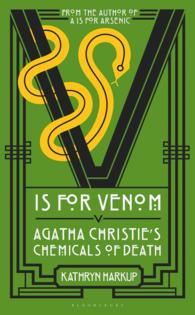Review: Agatha Christie poisoned hundreds of people. Here's how shedunit
Published in Books News
Dick Wolf might want to take a gander at “V is for Venom.”
Wolf is the creative force behind the various, long-running “Law & Order” shows, “Chicago” and “FBI” offshoots, too. Well over 1,000 episodes in, collectively, I figure he has to be running out of ways to off people. Enter the inventively homicidal Agatha Christie.
Over the course of her career, Christie came up with enough creative murder methods for her 78 crime novels, 150 short stories, 20 plays — and, now, two books that examine her methodology.
“V is for Venom” is Kathryn Harkup’s follow-up to “A is For Arsenic.” In both, she examines how Christie used chemicals to bring her characters to untimely ends. Christie picked up her murder expertise as a volunteer pharmacy assistant during World War I.
To get the job, she had to take a difficult course on pharmaceuticals and drug interactions and pass both written and practical exams. It proved a wonderful investment, career-wise — starting with her first novel, “The Mysterious Affair at Styles.” In it, she introduced detective Hercule Poirot and dispatched poor Emily Ingelthorp via a combination of strychnine, potassium bromide and an opiate (to delay the onset of symptoms).
What makes “Venom” a fun read is not just Christie’s ingenuity, but the back-up information Harkup provides — including how the poisons work and what real-life cases might have inspired Christie.
Take the short story, “The Lemesurier Inheritance,” for instance. Poirot, “using only the power of his little grey cells and no analysis whatsoever” — in other words, he pulled the answer out of his hat — deduced that the poison used was “Formic acid … Probably obtained by distilling ants.”
Sound far-fetched? Hardly. All the killer had to do, as Harkup explains, was “coax large numbers of ants into a vessel that could then be boiled to release the formic acid as a vapour, which could then be collected via a simple condenser.”
At first I thought Harkup might be writing with her tongue in her cheek. But when she offered the molecular formula for formic acid and explained how it worked, I realized she was probably just showing off.
She also explains how bees can be milked for their venom by running a current “through an electric grid covered with glass and placed at the entrance of the hive.” This will “induce the bee to sting. The venom will be deposited on the glass and can be scraped up afterwards.”
You won’t find this stuff by googling — at least without leaving a digital footprint for the cops.
Harkup also fills in the blanks when Christie, for example, doesn’t explain how a murderer could sprinkle anthrax on a shaving brush without becoming infected. He “could vaccinate himself before preparing his anthrax sample” and “be fairly certain that he would be protected, but his intended victim wouldn’t be.”
“V is for Venom” is chock-a-block full of these kinds of anecdotes. It’s a fascinating hoot and a half.
____
V is for Venom: Agatha Christie’s Chemicals of Death
By: Kathryn Harkup.
Publisher: Bloomsbury, 320 pages.
©2025 The Minnesota Star Tribune. Visit at startribune.com. Distributed by Tribune Content Agency, LLC.













Comments